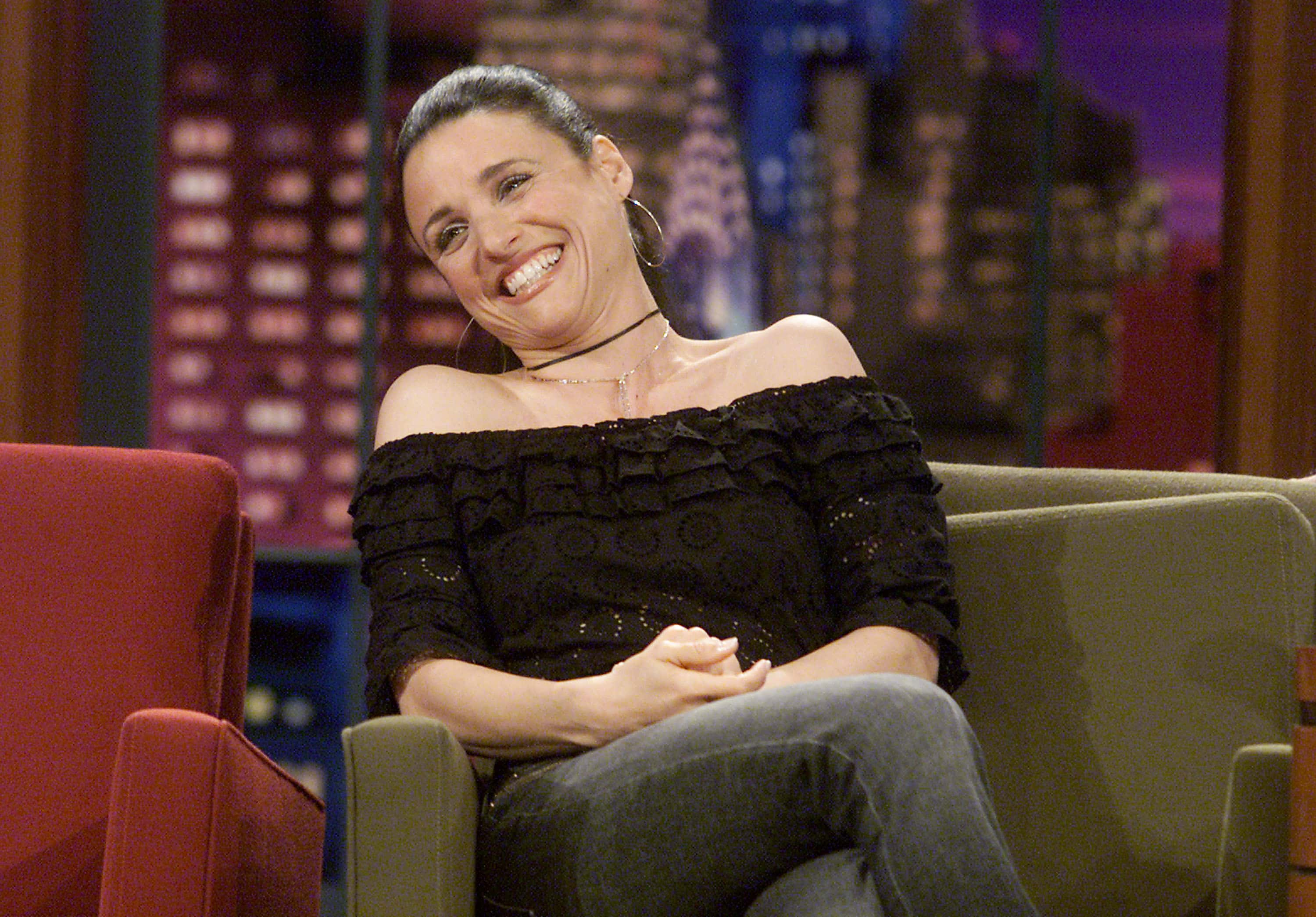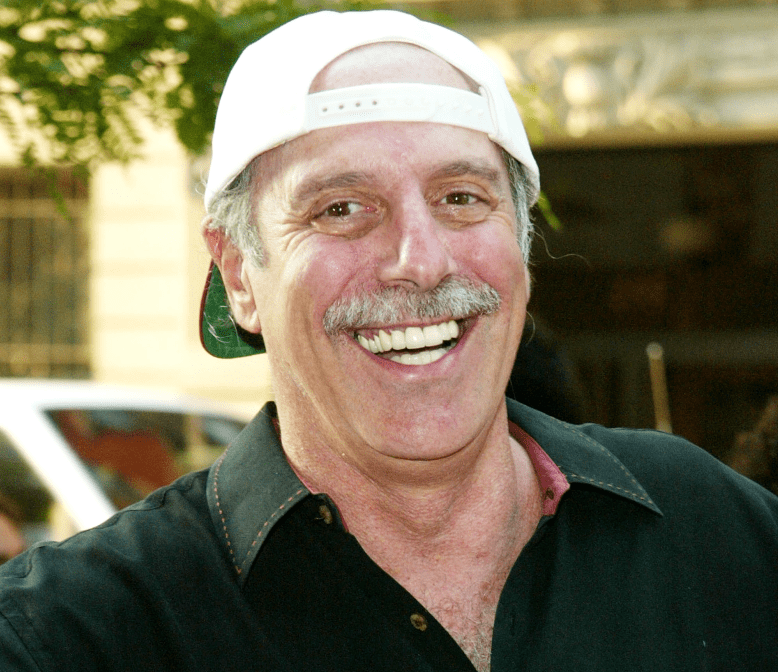“I'm sorry to bother you, but I'm a US postal worker and my mail truck was just ambushed by a band of backwoods mail-hating survivalists.” – Newman.
Here are our favorite facts about Seinfeld!
Seinfeld Facts
1. The Kramer entrance.
As Kramer became more popular, his entrance applause grew so loud and prolonged that the cast complained it was ruining the pacing of their scenes. Directors subsequently asked the audience not to applaud so much when Kramer entered.
 Castle Rock, Seinfeld (1989-1998)
Castle Rock, Seinfeld (1989-1998)
2. The title.
Every episode of the series except “Male Unbonding” begins with “The…” and names something from the episode. This was done because Jerry Seinfeld didn’t want the writers wasting time creating witty titles.
3. The real Soup Nazi.
After the “Soup Nazi” episode aired, Jerry Seinfeld visited the restaurant of the man it was based off, Ali Yeganeh. Ali began shouting a Jerry in a profanity-filled rant. Seinfeld responded with “the most insincere, sarcastic apology ever given.” Then, having seen the episode, Yeganeh bellowed “No Soup for You!” and ejected them from his restaurant.
 Castle Rock, Seinfeld (1989-1998)
Castle Rock, Seinfeld (1989-1998)
4. The sentimentality rule.
Larry David famously instituted a policy of “no hugging, no learning.” This meant that the show must never give viewers sentimental or moral lessons. Also, Jerry insisted that the characters must never learn or grow from their wrongdoings.
 Angela George, CC BY-SA 3.0, Wikimedia Commons
Angela George, CC BY-SA 3.0, Wikimedia Commons
5. The candy controversy.
M&M and Lifesaver turned Seinfeld down when looking for a candy to use in the famous “Junior Mint” episode.
 Castle Rock, Seinfeld (1989-1998)
Castle Rock, Seinfeld (1989-1998)
6. The Jerry contract.
Jerry Seinfeld has made more than $400 million from syndication of Seinfeld since the final episode.
 Castle Rock, Seinfeld (1989-1998)
Castle Rock, Seinfeld (1989-1998)
7. The chance to be on the show.
Throughout Seinfeld’s run, the chance to sit in the first booth at Monk’s Cafe and be included in a scene, was auctioned off for charity.
 Castle Rock, Seinfeld (1989-1998)
Castle Rock, Seinfeld (1989-1998)
8. The tragic death.
Frank Sinatra’s death coincided with Seinfeld’s series finale. Sinatra’s ambulance was able to drive to his house and the hospital quickly because there wasn’t much traffic in Los Angeles; everyone was at home watching Seinfeld.
9. The full circle.
The very first episode opens with a conversation between George and Jerry about a button. The last episode closes with a conversation between George and Jerry (and Elaine and Kramer) about a button.
 Castle Rock, Seinfeld (1989-1998)
Castle Rock, Seinfeld (1989-1998)

Sign up to our newsletter.
History’s most fascinating stories and darkest secrets, delivered to your inbox daily. Making distraction rewarding since 2017.
10. The Newman!
Jerry says “Hello, Newman” only 15 times in the entire series.
 Castle Rock, Seinfeld (1989-1998)
Castle Rock, Seinfeld (1989-1998)
11. The lady cast late.
Julia Louis-Dreyfus (Elaine) didn’t appear in the series’ pilot episode. In fact, she was unaware that the episode existed until it was released as part of the DVD box set in 2004.
12. The mysterious Kramer.
Out of the four main characters, Kramer is the only one who never had an “inner monologue.” In other words, his inner thoughts are never heard throughout the series.
 Castle Rock, Seinfeld (1989-1998)
Castle Rock, Seinfeld (1989-1998)
13. The finale.
When the final episode aired in 1998, the TV Land network honored the occasion by airing no programming in the show’s timeslot. Instead, the network just showed a still photo of a closed office door.
 Castle Rock, Seinfeld (1989-1998)
Castle Rock, Seinfeld (1989-1998)
14. The Spielberg hat tip.
Director Steven Spielberg once commented that while filming Schindler’s List (1993), he got so depressed that he would watch tapes of “Seinfeld” episodes to cheer himself up.
15. The real-life Kramer.
The character of Cosmo Kramer is based on Kenny Kramer, a man who worked across the hall from Larry David. In a self-confessed move to cash-in on the sitcom’s popularity, Kenny formed the “Kramer Reality Tour,” a New York City tour that visits real-life locations featured in the sitcom.
 minds-eye, CC BY-SA 2.0, Wikimedia Commons
minds-eye, CC BY-SA 2.0, Wikimedia Commons
16. The inspiration for George.
Jason Alexander originally based his portrayal of George on Woody Allen, which is why he wore glasses. When he realized that George was actually based on Larry David, he started basing his performance on David’s mannerisms.
17. The million-dollar lawsuit.
Michael Costanza, Jerry Seinfeld’s friend whom George is named after, filed a $100-million lawsuit against Seinfeld, Larry David and NBC. Michael claimed invasion of privacy and defamation of character, seeking damages due to the show’s alleged use of his likeness. The case was dismissed.
 Castle Rock, Seinfeld (1989-1998)
Castle Rock, Seinfeld (1989-1998)
18. The flawless attendance record.
Jerry Seinfeld is the only cast member who appeared in all 180 episodes. Jason Alexander came in a close second, missing only one episode: “The Pen.”
19. The baby bump.
Julia Louis-Dreyfus was pregnant while shooting part of the series. Her pregnancy was disguised: she carried props to hide her changing body.
 Castle Rock, Seinfeld (1989-1998)
Castle Rock, Seinfeld (1989-1998)
20. The murder foreshadowing.
In the episode where Elaine dates a man named Joel Rifkin, she tries to have him change his name because Joel Rifkin is also the name of a man involved in a notorious New York City murder case. One of the initial suggestions for a new name was O.J. This episode was shot in 1993, a year before O.J. Simpson was accused of murdering his ex-wife Nicole Brown Simpson and Ron Goldman.
 Castle Rock, Seinfeld (1989-1998)
Castle Rock, Seinfeld (1989-1998)
21. The puffy shirt.
The puffy shirt used in “The Puffy Shirt” episode is currently placed in the Smithsonian. A doll-sized replica was included with the fifth season DVD set.
 Narith5, CC BY 2.0, Wikimedia Commons
Narith5, CC BY 2.0, Wikimedia Commons
22. The big number 100.
Kramer’s famous “I’m out of the contest!” moment was his 100th entrance into Jerry’s apartment.
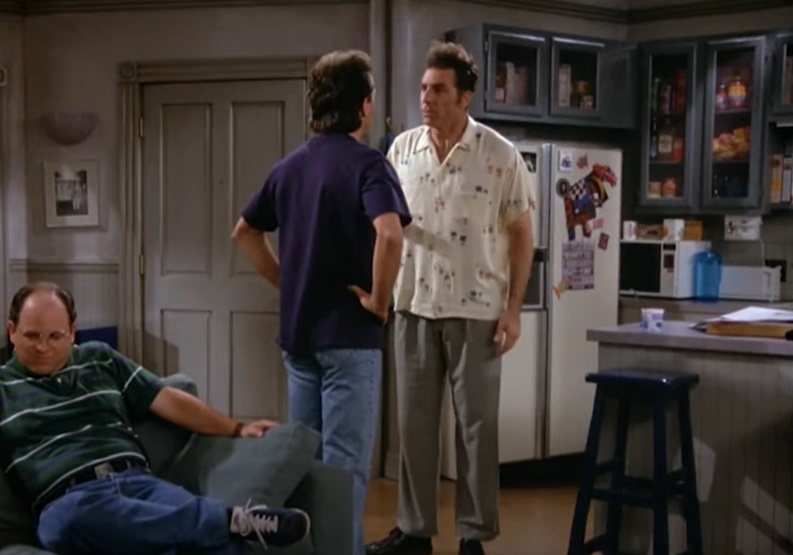 Castle Rock, Seinfeld (1989-1998)
Castle Rock, Seinfeld (1989-1998)
23. The formidable Alton Benes.
It was originally intended that Elaine’s father, famous author Alton Benes, be a recurring character, but in an odd case of life imitating art, the veteran character actor Lawrence Tierney so terrorized and intimidated the other cast members that Jerry and Larry decided he should never return.
 Castle Rock, Seinfeld (1989-1998)
Castle Rock, Seinfeld (1989-1998)
24. The apartment set.
The apartment used for exterior shots, 129 West 81st Street in New York, is not actually in New York at all. It’s located at 757 S. New Hampshire Avenue, Los Angeles, California. There’s a Taco Bell directly across from it.
 Castle Rock, Seinfeld (1989-1998)
Castle Rock, Seinfeld (1989-1998)
25. The 10th season.
NBC made Jerry Seinfeld an offer that would have made him $110 million for a 10th season of the show. Jerry turned it down.
26. The curious case of Newman’s name.
Newman doesn’t have a first name. A common speculation is that his first name is “Norman” because in the episode “The Bottle Deposit, Part 2” the farmer’s daughter shouts, “Goodbye, Norman!” This was actually the actress’s mistake — she mistook “Newman” for “Norman” in the script. Seinfeld‘s producers found the mistake funny, so they kept the error.
 Castle Rock, Seinfeld (1989-1998)
Castle Rock, Seinfeld (1989-1998)
27. The birth of Newman.
Newman made his debut appearance in the seventh episode of the second season, but the role was voice only, and was portrayed by series co-creator Larry David. Newman first appeared in on screen in the episode “The Suicide” in the third season.
 Castle Rock, Seinfeld (1989-1998)
Castle Rock, Seinfeld (1989-1998)
28. The real apartment.
Jerry’s address is mentioned numerous times in the series as 129 W. 81st Street. Real-life Jerry actually owns a building called The Beresford at 211 Central Park West—about a block away from his fictional locale.
 Castle Rock, Seinfeld (1989-1998)
Castle Rock, Seinfeld (1989-1998)
29. The ultimatum.
The very first (and only) episode in which George Costanza’s character doesn’t appear is “The Pen.” In an interview with Access Hollywood, Jason Alexander describes this incident as one of the “few” problems he ever had with series creator Larry David. Worried that he was on the path to being written out of the show, Alexander confronted David, saying, “Larry if you do it again, do it permanently.”
30. The turn down.
Jerry Seinfeld initially offered the role of George Costanza to Jake Johannsen, a critically acclaimed stand-up comedian whose HBO comedy special This’ll Take About an Hour was listed as one of People magazine’s 10 Best Television Shows in 1992. Johannsen refused the role, despite being “begged” by Jerry.
31. The first Elaine.
Elaine’s character wasn’t originally cast. Jerry‘s first conception of the female role was a sassy waitress named Clair played by actress Lee Garlington. After the pilot was filmed, the creators felt Garlington wasn’t a good fit and sought out a replacement.
32. The Elaine Vs. Julia dispute.
Elaine’s and Julia Louis-Dreyfus’s lives couldn’t have been more different. Elaine dates a melting pot of single men in Seinfeld, while Louis-Dreyfus married at age 20. Julia said of Elaine that, “She’s nuts. The woman’s nuts … I’m sure it’s a self-esteem problem. I mean, she’s hanging out with these three guys, in that ratty apartment — where’s the self-esteem there?”
33. The voice of Larry.
Larry David’s most famous voice-role in Seinfeld was that of Yankees-owner George Steinbrenner. He also voiced the MTA subway announcer, Saddam Hussein, a boxing referee, a soap opera director, and the man who says “Is anyone here a marine biologist?” All of Larry David’s voicework in Seinfeld is uncredited.
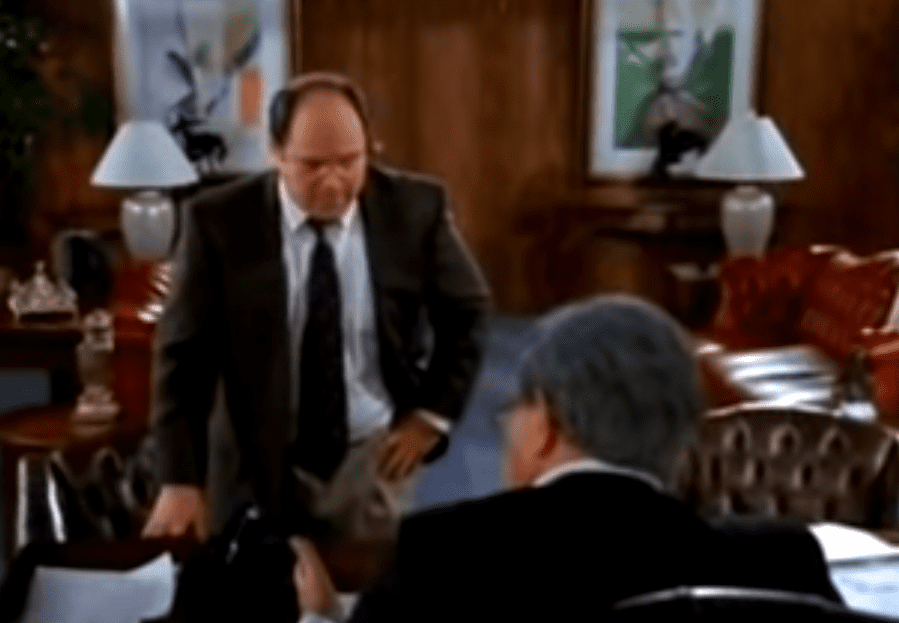 Castle Rock, Seinfeld (1989-1998)
Castle Rock, Seinfeld (1989-1998)
34. The déjà vu.
Before co-creating Seinfeld with Jerry Seinfeld, Larry David wrote for ABC’s Fridays. He then worked a brief, year-long stint for Saturday Night Live (where he met future colleague Julia Louis-Dreyfus). Here, only one of his sketches was ever aired: a skit where an assumedly frustrated David quits SNL midseason and returned a few days later, acting as if nothing had happened.
In the Seinfeld episode “The Revenge,” George quits his job after being banned from the executive bathroom, regrets it immediately, and shows up back to work as if nothing happened, hoping that his boss will have forgotten that he quit. Ring any bells?
35. The coffee shop.
Monk’s, the coffee shop where the characters most often hang out, is modeled after an Upper West Side café called Tom’s Restaurant, which is still in operation today
36. The Kramer backstory.
Throughout Seinfeld, a number of details are revealed about what Kramer’s life looked like before the series began: a man in the park exposed himself to Kramer when Kramer was a young boy, he grew up in a strict household with a mandatory 9pm bedtime, he ran away from home at age 17, he didn’t graduate high school but has a GED, he has an estranged relationship with his mom, he’s the last line of males in his family, he has a deaf cousin who taught him ASL, he was in the Army, he lived in LA, and he once was struck in the head by a falling air conditioner while walking on the sidewalk.
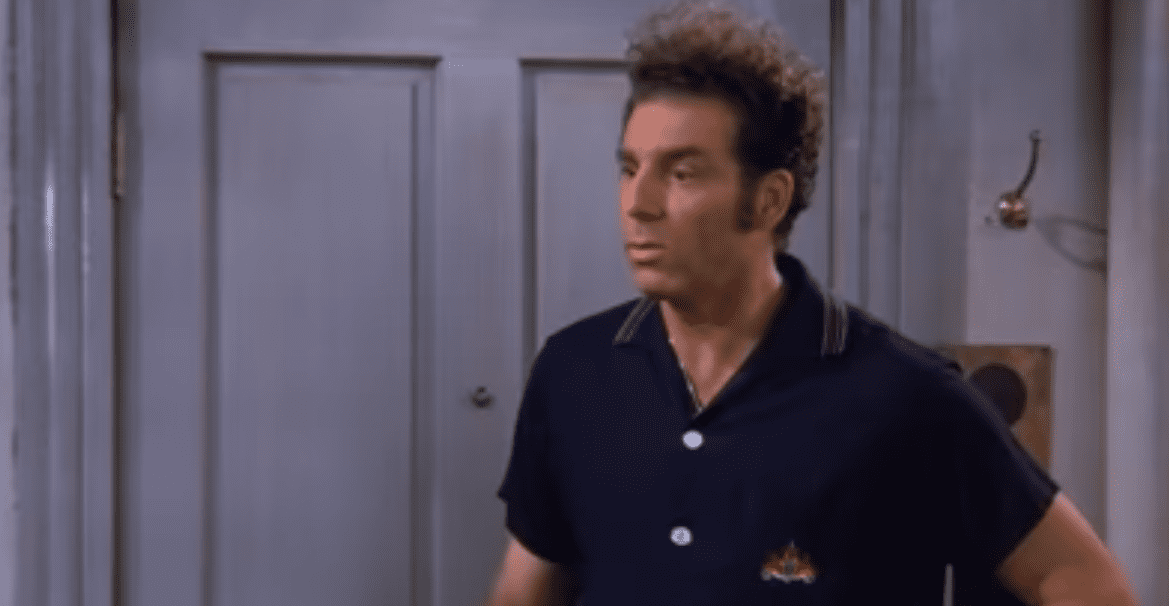 Castle Rock, Seinfeld (1989-1998)
Castle Rock, Seinfeld (1989-1998)
37. The stand-up routines.
For the first three seasons, the show used Jerry’s stand-up act to bookend episodes and as transitional scenes. In seasons 4 and 5, the show’s writers stopped using his stand-up for scene transitions. During season 6, episode plotlines got denser and Seinfeld’s stand-up acts at the end of episodes were cut, and by the end of season 7, stand-up was cut entirely. The stand-up act reappeared only once more in the series finale to bookend the episode.
38. The big secret.
To make sure fans didn’t know what would happen, Seinfeld‘s series finale was filmed in front of a small group of NBC executives and friends of the show instead of their normal studio audience. Attendees were required to sign written “vows of silence.” Further increasing hype, Seinfeld‘s producers spread false rumors about that included Newman dying and Elaine and Jerry getting married.
 Castle Rock, Seinfeld (1989-1998)
Castle Rock, Seinfeld (1989-1998)
39. The paycheck.
Larry David secured a $1.7 billion syndication deal after Seinfeld ended. Of this, he made $250 million in 1998 alone and payments will continue until the $1.7 billion is reached.
40. The toilet brush.
In Season 8's "The Pothole," Jerry's girlfriend's toothbrush falls into the toilet and she uses it before he can tell her. This debacle was inspired by the real-life experience of writer Dan O'Keefe. His then girlfriend, now wife, used her toothbrush before he could tell her it had fallen into the toilet.
 Castle Rock, Seinfeld (1989-1998)
Castle Rock, Seinfeld (1989-1998)
41. The favorite number.
Jerry Seinfeld's fascination with the number nine factored into his decision to end Seinfeld after nine seasons. "Nine is cool. By the end, we will have done 180 shows (1+8=9). When I was thinking about quitting the show, I thought, nine. People said, '10 — why not 10?' But 10 is lame. Nine is my number. And then I found out that nine in numerology means completion.”
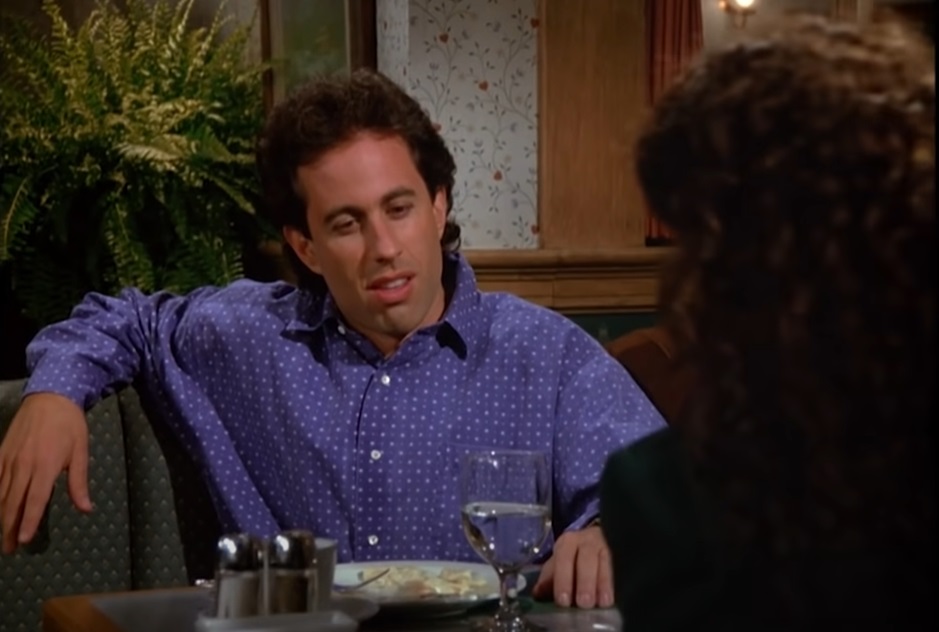 Castle Rock, Seinfeld (1989-1998)
Castle Rock, Seinfeld (1989-1998)
42. The mean tailor.
Jason Alexander's wardrobe for George Costanza was often made one size too small, which added to the portrait of George as perpetually annoyed.
 Castle Rock, Seinfeld (1989-1998)
Castle Rock, Seinfeld (1989-1998)
43. The deal well struck.
Kenny Kramer, Larry David's real-life former neighbor, was paid just $1,000 to allow the series to use his name. However, real-life Kramer has profited from his association with the show as the proprietor of the Kramer Reality Tour, a Seinfeld-centric bus ride through New York City that, more than 15 years after the series finale, still sells out.
44. The big entrance.
Michael Richards makes his first sliding Kramer entrance in Episode 3, "The Robbery." He did it another 284 times by series' end.
 Castle Rock, Seinfeld (1989-1998)
Castle Rock, Seinfeld (1989-1998)
45. The other George Costanza options.
David Letterman bandleader Paul Schaffer, Nathan Lane, Steve Buscemi, and Danny DeVito were considered for the role of George Costanza.
46. The other Elaine options.
Patricia Heaton and Rosie O'Donnell were considered for the role of Elaine. O’Donnell ended up finding a better fit for herself on her eponymous daytime talk show a few years later.
47. The puffy shirt returns.
After Jerry Seinfeld was caught dating a 17-year-old Shoshanna Lonstein, it was reported that he said, "This is the only girl I ever went out with who was that young. I wasn't dating her. We just went to a restaurant, and that was it." Jerry's tone changed as their relationship continued to evolve, eventually saying, "Shoshanna is a person, not an age. She is extremely bright. She's funny, sharp, very alert. We just get along. You can hear the click." The couple dated for four years during the filming of the show, a relationship that made some viewers uneasy. However, the relationship didn't seem to harm Seinfeld’s ratings, which remained high up until the finale!
48. The replacement episode.
Seinfeld had its controversies, but the most controversial episode was the one that turned off the cast so much they didn't even film it. "We had a script that the actors and I started to work on and none of us liked it," director Cherones explained. "It was about a gun, and guns aren't funny. I went back to the office that first day, after we were sent down to rehearse, and said, 'We don't want to do this one.' And Larry and the Castle Rock executives whom we talked to all agreed, and Larry wrote another script." When the script was tossed out, it was replaced with "The Phone Message."
Yada, yada, yada, Seinfeld is awesome! Share this with your friend by clicking below to honor this long-running comedy goldmine!











